|
|
|
|||||||
|
The poem is tightly-structured, with four eight-line stanzas and a refrain following a difficult rhyme-scheme: ababbbbc (stanza), dddc (refrain), with the c-rhyme repeated through the four stanzas. This can force some discontinuity on the sequence of thought (most obviously in lines 15-16). There is also extensive use of alliteration, but decorative rather than structural. The number of strongly-stressed syllables in the line varies between three and four; in the refrain, and in the second and third stanzas, all lines except the last are four-stress, but in the first stanza only the first, third, and sixth are, and in the last only the first, third, and fifth.
|
|||||||
|
|
|
|||||||
| Set up by Bella Millett, enm@soton.ac.uk. Last updated 24 July 2003 . London, British Library, MS Harley 2253, f. 63v, reproduced by permission of the British Library; no further reproduction permitted. |
 This poem,
sometimes known from its addressee as 'Alysoun', follows a common pattern in medieval
love-poetry in its linking of a spring opening with the lover's hopes and sufferings. In
spite of his complaints, however, the upbeat refrain ensures that cheerfulness keeps
breaking in; and his already-traditional protestations of subjection, sleeplessness,
longing, and despair are presented with an optimistic panache.
This poem,
sometimes known from its addressee as 'Alysoun', follows a common pattern in medieval
love-poetry in its linking of a spring opening with the lover's hopes and sufferings. In
spite of his complaints, however, the upbeat refrain ensures that cheerfulness keeps
breaking in; and his already-traditional protestations of subjection, sleeplessness,
longing, and despair are presented with an optimistic panache.